TEMPORAL BONE PARAGANGLIOMAS (CHEMODECTOMAS)
KEY POINTS
- Paragangliomas occur at several sites and pose significant treatment challenges in many cases if significant functional losses are to be avoided.
- Precise imaging is critical to a proper differential diagnosis and medical decision making.
INTRODUCTION
Etiology
The paraganglia cells of neural crest origin give rise to usually sporadically occurring temporal bone tumors, including glomus tympanicum in the middle ear, glomus jugulare in the jugular fossa, and a hybrid jugulotympanic tumor that may extend from the bone lying between the carotid canal and jugular fossa into the hypotympanum (Fig. 123.1). No specific etiology has been identified; however, a genetic basis for these tumors in patients with familial disease and multiple endocrine neoplasia (MEN) syndromes has been established.
In general, the frequency of occurrence of these tumors at these various sites parallels the density distribution of the extra-adrenal paraganglia. There is a tendency for their occurrence to be multicentric, with this being most apparent in the hereditofamilial forms of the disease. In cases where multiple tumors are present, carotid body tumors and glomus vagale tumors are most frequently encountered in combination with temporal bone tumors.
Prevalence and Epidemiology
Temporal bone paragangliomas are generally sporadic tumors of adults that manifest after 20 years of age. Cases between the ages of 10 and 20 years have been reported.
Familial paragangliomas can occur, and genetic research has revealed that these forms are much more common than previously thought, being seen in up to 24% of cases.1 Specific gene defects have been described. Some tumors in the familial forms of the disease, including MEN syndromes, have a tendency for malignant degeneration and may be associated with medullary carcinoma of the thyroid and renal cell carcinoma. MEN syndromes 2A and 2B, von Hippel-Lindau disease, and neurofibromatosis type 1 also have a genetic predisposition to develop abdominal paragangliomas.
Clinical Presentation
The presenting symptoms of a temporal bone paraganglioma depend on the specific site of origin. Tumors arising in or near the middle ear present with conductive hearing loss and/or pulse synchronous tinnitus (Chapter 109). Tumors of the jugular fossa can also cause headache, which often is pulsatile in nature and referred to the ear and periauricular region.
Physical examination of patients with tumors arising in association with the temporal bone may show a bluish-red mass behind the tympanic membrane or occasionally in the external auditory canal.
There may be dysfunction of cranial nerves V through XII and the sympathetic nerves. Vagal neuropathy manifests as vocal cord paralysis and is the most likely presenting complaint related to the lower cranial nerves. The rare lesion of facial canal origin may present as facial weakness. Advanced lesions are more likely to present with multiple cranial nerve palsies, headaches, and symptoms and signs of increased intracranial pressure.
Palpable lymph node metastases are rare.
Whereas abdominal paragangliomas develop from sympathetic paraganglia or the adrenal gland and often present with catecholamine excess, head and neck paragangliomas arise from parasympathetic paraganglia and may very infrequently be associated with an endocrine dysfunction similar to pheochromocytoma or carcinoid tumor, with the predominant manifestation being intermittent hypertension. Other endocrine-related symptoms may include diarrhea, headaches, and flushing.
Pathophysiology
Anatomy
The normal anatomy pertinent to the evaluation of paragangliomas includes primarily that of the temporal bone, posterior skull base, posterior fossa, and retrostyloid parapharyngeal space (Fig. 123.1 and Chapters 104 and 144). Since the unusual malignant varieties of these tumors can metastasize to lymph nodes, the anatomy along the carotid sheath should be reviewed, if necessary. The following anatomy and its variations must be understood in detail.
For glomus tympanicum, jugulotympanic, glomus faciale, and jugular fossa tumors:
 Temporal bone: Emphasis on the hypotympanum, promontory, inferior tympanic canaliculus, caroticotympanic canal, descending facial canal and facial nerve, carotid canal, and jugular fossa (Fig. 123.1 and Chapter 104)
Temporal bone: Emphasis on the hypotympanum, promontory, inferior tympanic canaliculus, caroticotympanic canal, descending facial canal and facial nerve, carotid canal, and jugular fossa (Fig. 123.1 and Chapter 104)
 Posterior fossa and posterior skull base: Jugular fossa, jugular tubercle, brain stem, related cisterns, and cranial nerves V through XII (Chapter 104)
Posterior fossa and posterior skull base: Jugular fossa, jugular tubercle, brain stem, related cisterns, and cranial nerves V through XII (Chapter 104)
 Vascular structures: Jugular bulb, sigmoid sinus, transverse sinus and superior and inferior petrosal sinus, and hypoglossal canal; vertebral basilar intra-axial and extra-axial supply (Chapter 104)
Vascular structures: Jugular bulb, sigmoid sinus, transverse sinus and superior and inferior petrosal sinus, and hypoglossal canal; vertebral basilar intra-axial and extra-axial supply (Chapter 104)
For glomus jugulare tumors extending below the skull base:
 Retrostyloid parapharyngeal space and carotid sheath—in particular, the jugular vein (Chapter 144)
Retrostyloid parapharyngeal space and carotid sheath—in particular, the jugular vein (Chapter 144)
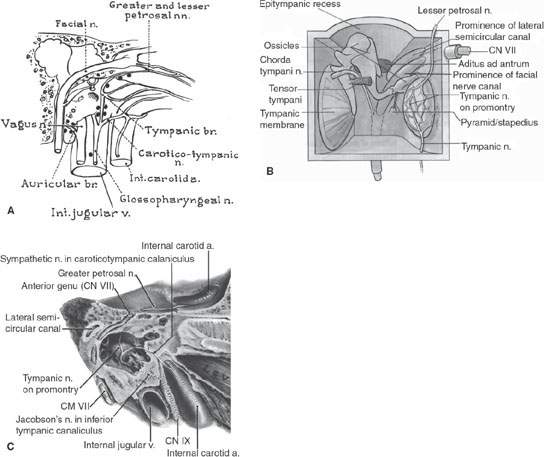
FIGURE 123.1. A: Drawing of the location of a paraganglia in relation to neurovascular structures within and around the temporal bone. B: Schematic drawing illustrating the course of the Jacobson nerve through the inferior tympanic canal to the middle ear (usually to the promontory). C: Anatomic drawing of the course of the Arnold nerve (auricular branch of nerve X) and the Jacobson nerve (tympanic branch of nerve IX).
Pathology and Patterns of Disease
The glomus bodies of neural crest origin as the source of these tumors are discussed in Chapter 33. Temporal bone glomus bodies are distributed along the glossopharyngeal and vagus nerves. About one half of the glomus bodies are found in and around the jugular fossa within the adventitia of the jugular bulb (Fig. 123.1A). The remainder are distributed along the course of the Jacobson branch of the glossopharyngeal nerve; these lie along the inferior tympanic canaliculus and within the mucosa of the middle ear over the cochlear promontory (Fig. 123.1B,C). Glomus bodies are also located along the descending facial canal and along the course of the Arnold nerve. This auricular branch of the vagus nerve arises from the superior ganglion of cranial nerve X and reaches the descending facial nerve canal via the mastoid canaliculus.
The pathology, morphology, and growth patterns of paragangliomas are discussed in detail in Chapter 33. A particularly important feature in the temporal bone is that these typically benign tumors virtually always show an indistinct aggressive-appearing erosive pattern along their interface with bone of the jugular fossa (Figs. 33.1–33.3 and 123.2–123.7). Such bone erosion is also a prominent feature of those lesions arising within the bone between the carotid canal and jugular fossa along the inferior tympanic canaliculus (Figs. 123.2A and 123.3–123.5). Also, the tumors tend to compress rather than invade adjacent cranial nerves although both can occur. If pressure is diminished, there is a very limited potential for preservation of residual function and occasionally return of some lost function. Intracranial growth may be extradural or intradural depending of the site of entry. Such growth may be along or within the dural venous sinuses and jugular vein (Figs. 123.2E–G and 123.6–123.10).
Glomus tympanicum tumors arise deep to the middle ear mucosal surfaces from the glomus bodies along the Jacobson nerves predominantly on and around the cochlear promontory (Figs. 123.1, 123.2A, and 123.3–123.5). A minority arises from paraganglia around the Arnold nerve. These tumors tend to be small when diagnosed because they cause prominent pulse synchronous tinnitus and are often readily visible on physical examination.
Locally advanced glomus tympanicum (also referred to as glomus hypotympanicum) tumors may be referred to as jugulotympanic since they arise between the middle ear and jugular fossa. They likely arise from the paraganglia in the caroticotympanic and inferior tympanic canaliculi (Figs. 123.1, 123.4, and 123.5). They may also arise over the promontory and spread along pathways created by infralabyrinthine air cell tracts that communicate with the hypotympanum. These have the same spread potential as glomus jugulare tumors but are normally discovered much earlier.
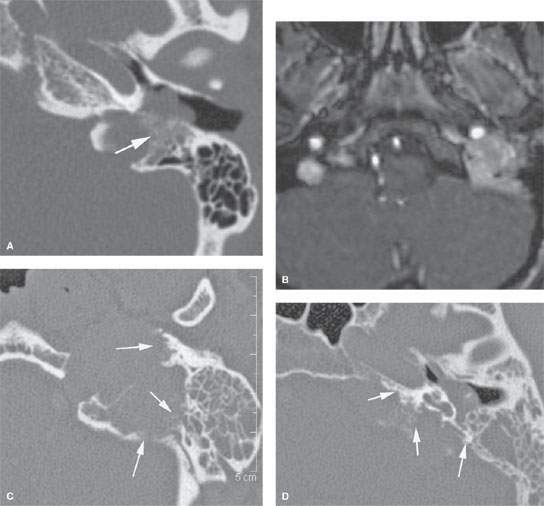
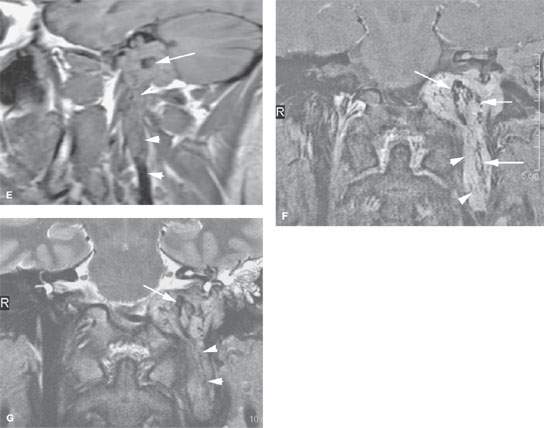
FIGURE 123.2. Two patients to illustrate the typical aggressive bone erosion and other general morphologic findings of larger paragangliomas on computed tomography (CT) and magnetic resonance imaging (MRI) to emphasize some limitations of these modalities if used individually. A, B: Patient 1 with a glomus jugulare type of paraganglioma. In (A), CT shows irregular bone destruction (arrow) of the wall of the jugular foramen and surrounding permeative bone changes. In (B), contrast-enhanced MRI shows the enhancing tumor with the bone erosion not as apparent as on the CT and only subtle intralesional flow voids. C–G: Patient 2. CT and MRI of an advanced glomus jugulare type of paraganglioma. In (C), CT through the mastoid shows an aggressive pattern of bone destruction at the margins of the tumor (arrows). In (D), a section somewhat more cephalad than that in (C) shows aggressive bone destruction continuing from the mastoid portion of the temporal bone to the junction of the petrous segment and the clivus (arrows). In (E), non–contrast-enhanced T1-weighted (T1W) MRI shows a series of flow voids within the tumor. A main vascular pedicle is seen superiorly (arrows), and smaller flow voids are seen within the mass as it spreads within the jugular vein (arrowheads). In (F), the contrast-enhanced T1W fat-suppressed image shows the extensive enhancing tumor with numerous vascular channels within the tumor (arrows) and extension of the tumor by growth within the jugular vein (arrowheads). In (G), the T2-weighted coronal image shows the large vascular channels (arrow) and the smaller vascular channels (arrowheads) growing within the component of the tumor in the jugular vein.
Glomus jugulare tumors arise in the jugular fossa over the dome of the jugular bulb from paraganglia in the adventitia (Figs. 123.1 and 123.6–123.10). They grow radially to involve the mastoid, middle ear, and posterior fossa and may extend within and along dural venous sinuses and the jugular vein, eventually through the skull base. Growth along the inferior petrosal sinus can be particularly insidious. Growth within the jugular vein (Figs. 123.2E–G, 123.6, and 123.7) may rarely extend to the heart, and tumor and thrombus can break off into the pulmonary circulation.
The rare glomus faciale tumor arises from paraganglia along the facial canal (Figs. 123.1 and 123.11)
Paragangliomas have some malignant potential, which is best determined by their clinical behavior rather than histologic criteria (Chapter 33).
Pathologically Altered Function
The presenting symptoms of temporal bone tumors depend on the specific site of origin. Tumors arising in or near the middle ear commonly present with conductive hearing loss and/or pulse synchronous tinnitus. Tumors of the jugular fossa may cause headache often pulsatile in nature and referred to the ear and periauricular region. These may cause dysfunction of cranial nerves V through XII and the sympathetic nerves. The rare lesion of facial canal patients may present with facial weakness. Advanced lesions are more likely to present with multiple cranial nerve palsies.

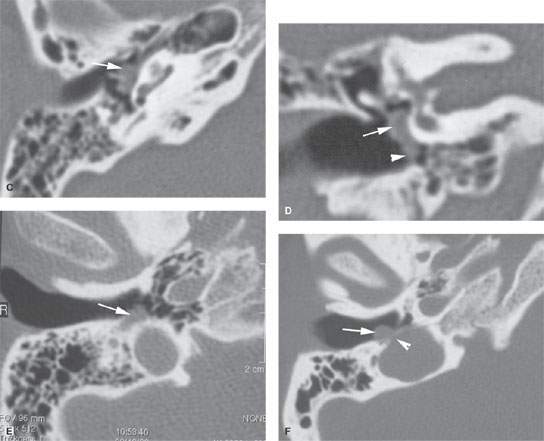
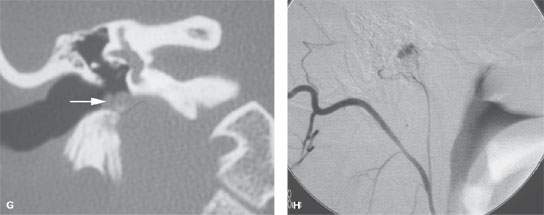
FIGURE 123.3. Images of four patients with relatively small paragangliomas. A, B:Patient 1. Computed tomography (CT) and magnetic resonance (MR) studies showing a small paraganglioma within the middle ear (arrows). The arrowhead in (B) shows the carotid artery and how enhancing structures might lead to ambiguity in diagnosis in small paragangliomas on MR examination. C, D: Patient 2. A patient with a paraganglioma limited to the middle ear. In (C), the tumor surrounds the ossicles (arrow) as it lies along the promontory. In (D), the coronal image shows that while the tumor fills most of the mesotympanum (arrow), its inferior margin does not grow into the infralabyrinthine bone (arrowhead). E: Patient 3 presenting with pulse synchronous tinnitus and a mass (arrow) visible in the external auditory canal (EAC) behind the tympanic membrane in the hypotympanum. The mass erodes the bone over the jugular fossa and within the facial recess. F–H: Patient 4 presenting with pulse synchronous tinnitus and a mass visible in the EAC adjacent to the tympanic membrane. In (F), the mass is eroding bone of the EAC but appears separate from the jugular fossa on this section. On a coronal section, the mass appears to be causing demineralization of bone of the jugular fossa (arrowhead in G) as it projects into the EAC (arrow) with the adjacent soft tissue mass projecting into the EAC. (NOTE: The CT study could not make certain whether this was the tip of a larger glomus tumor arising within the jugular fossa or a limited lesion.) In (H), an angiogram shows the ascending pharyngeal artery producing supply to the tiny paraganglioma arising over the dome of the jugular bone.
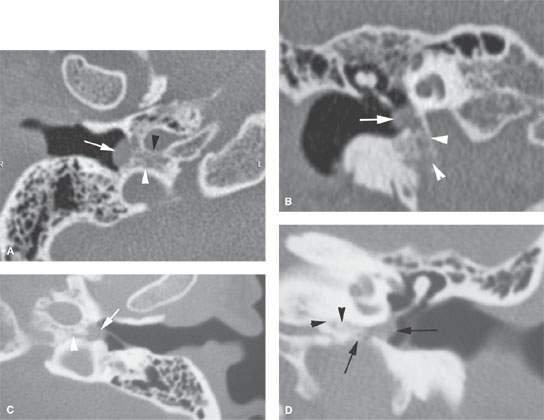
FIGURE 123.4. Computed tomography (CT) findings in two patients with jugulotympanic paragangliomas. A, B: Patient 1. CT shows a well-defined soft tissue mass in the hypotympanum (arrows) with aggressive-appearing bone erosion between the jugular fossa and carotid canal (arrowheads). The inner cortex of the jugular foramen and carotid canal are intact but undermined by tumor along their outer cortical margins. C, D: Patient 2. A patient presenting with pulse synchronous tinnitus. CT study was done. There is a small mass in the hypotympanum (arrow) that appears to be growing into the bone along the intralabyrinthine air cell tract (arrowhead) without producing obvious erosion of the carotid canal or jugular fossa. In (D), the coronal image confirms the glomus tumor arising in the hypotympanum and extending into infralabyrinthine bone (arrows) with possible more medial extension in bone (arrowheads). (NOTE: Patients such as those shown in this figure sometimes are mistaken to have tumors limited to the middle ear cavity resulting in partial resection. The patients’ symptoms then remain unrelieved or recur soon after surgery, necessitating repeated treatment.)
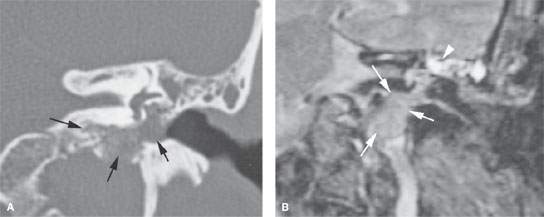
FIGURE 123.5. Computed Tomography (CT) and MRI imaging of a patient with an advanced jugulotympanic paraganglioma with obstructive secretions in the mastoid. Computed tomography in (A) shows erosion of the jugular fossa and considerable medial spread along the infralabyrinthine bone paralleling the carotid canal posteriorly (arrows). It is hard to say where the tumor begins and ends in the middle ear cavity and mastoid. The T2-weighted image in (B) shows the paraganglioma tissue to be of obviously less signal intensity (arrows) then the fluid in the mastoid (arrowhead).
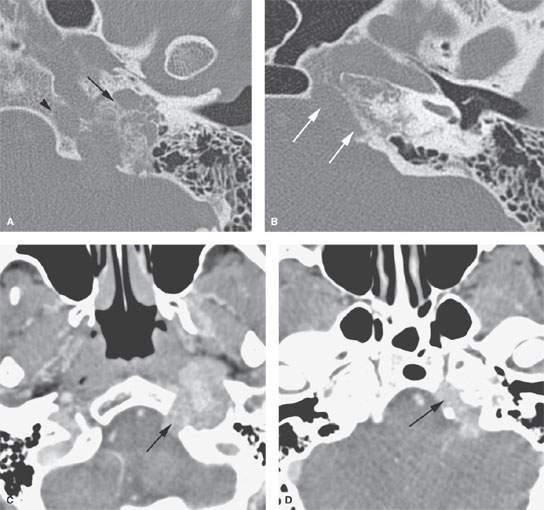
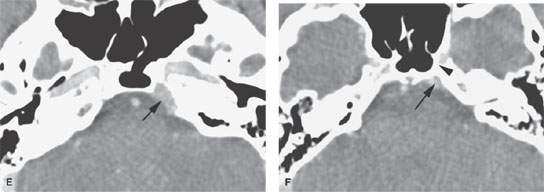
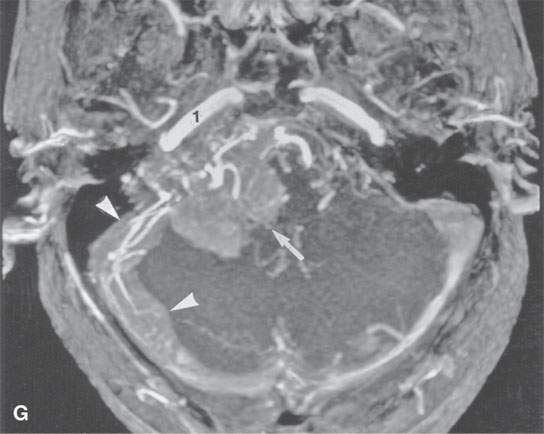
FIGURE 123.6. Two patients with an extensive glomus jugulare type of paraganglioma demonstrating intracranial spread and involvement of major dural venous sinuses. A–F: Patient 1. In (A), aggressive bone involvement of the carotid canal (arrow) extending out of the petrous apex to involve the clivus (arrowhead) is present. In (B), a somewhat more cephalad section than seen in (A) shows tumor spreading along the petrous apex in a position strongly suggesting spread along the superior petrosal sinus (arrows). In (C), at soft tissue window settings, the tumor can be seen invading the hypoglossal canal (arrow). In (D), the tumor extends from the jugular fossa along the petrous apex in a matter consistent with spread in the inferior petrosal sinus (arrow). In (E), further spread is seen along the enlarged inferior petrosal sinus (arrow). In (F), spread to the expected junction of the inferior and petrosal sinus (arrow), suggesting some possible continuity between the petrosal sinuses and the cavernous sinus region (arrowhead). G: Patient 2 illustrating extensive intracranial, intradural spread of tumor (arrow) as well as spread within the sigmoid and transverse sinuses including the enhancing tumor and related large feeding vessels (arrowheads).
Stay updated, free articles. Join our Telegram channel

Full access? Get Clinical Tree








